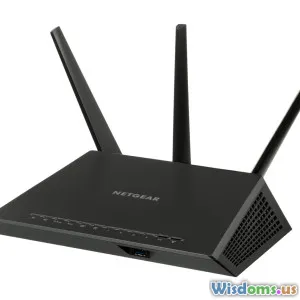
Smart TVs on a Budget Can Affordable Models Compete in 2024
14 min read Explore whether affordable smart TVs in 2024 deliver quality and performance, comparing top budget models, tech features, and real-world value to premium competitors. (0 Reviews)
Smart TVs on a Budget: Can Affordable Models Compete in 2024?
Introduction: The Screen Wars Enter a New Era
Imagine walking into your living room, pressing a button, and finding yourself just a click away from your favorite streaming service, YouTube channel, or sports match—without needing a high-end TV that costs as much as a month’s rent. In 2024, the smart TV market isn’t solely a playground for pricey OLED giants or flagship QLED marvels. Instead, a new question takes center stage: Can affordable smart TVs genuinely compete with their premium counterparts? As technology becomes democratized and brands battle for market share, consumers are in for a fascinating ride. This deep dive unpacks whether budget-friendly smart TVs truly deliver where it counts—and if upgrading to the pricier model is still the best move.
Smart TV Landscape in 2024: What’s Changed?
In just five years, the smart TV industry has undergone a dramatic transformation. Where budget models once lagged miles behind top-tier sets in terms of display quality and user experience, 2024’s landscape is a different story. Global shipments of smart TVs are projected to hit over 260 million units this year, according to Statista. More than half of global households now own a smart TV, and brands like TCL, Hisense, and Xiaomi—considered “budget” just a few years back—are making palpable waves.
Cheaper, But Not Cheap: The New Meaning of ‘Budget’
It’s important to distinguish between “cheap” and “affordable.” The $300 no-name TVs of the past were cost-cutting nightmares—limited ports, dim screens, laggy interfaces—while today’s affordable sets from reputable brands offer something closer to “value-priced excellence.” Rapid improvements in manufacturing, open-source operating systems (think Google TV, Fire TV), and falling panel prices mean consumers have never had so much quality at such accessible prices.
Breaking Down the Myths: Where Budget TVs Deliver—and Where They Don’t
1. Picture Quality: Is Good Enough... Good Enough?
Premium TVs dazzled with quantum dot or OLED screens, deep blacks, and insane color accuracy. Yet, technological trickle-down is blurring these divides. Take the Hisense U6K: offering a mini-LED panel, full-array local dimming, and Dolby Vision in 2024—for under $500.
- Mini-LED and QLED Panels: Once exclusive to premium brands, affordable models like TCL’s Q6 Series now pack QLED panels, offering richer colors and higher peak brightness than older budget LEDs.
- 4K Resolution is Standard: Even $300 models, such as the Amazon Fire TV 4-Series, deliver crisp 4K visuals. For non-videophiles, differences in detail between a midrange and high-end 4K are negligible at typical viewing distances.
- HDR Support: While not all budget sets handle HDR10+ or Dolby Vision perfectly (some dim HDR content or lack ‘wow’ contrast), they undercut expensive models by handling everyday viewing scenarios with ease.
Example: Consumer Reports ranked a $400 TCL 5-Series nearly on par, in practical viewing tests, with a flagship Samsung QLED twice the price for most living room conditions.
Quote: “Unless you’re shooting for a dedicated home theater, today’s midrange TV delivers a viewing experience 90% as good as flagship sets,” notes Mark Spoonauer, TechRadar’s editor-in-chief.
2. Operating Systems & User Experience: The Heart of Modern TV
Clunky menus and app store deserts once plagued affordable sets. That shifted as TV brands began licensing world-class operating systems:
- Google TV and Roku TV: Smooth UIs, vast app selections, regular security updates, and casting built-in. TCL and Hisense, in particular, leverage these for excellent out-of-the-box experiences.
- Fire TV and Tizen: Amazon’s Fire TV 4-Series brings Alexa controls and personalized recommendations, while Samsung’s affordable Crystal UHD line uses a slimmed-down Tizen OS.
Case Study: The new Xiaomi TV A Pro series uses Google TV, giving users access to thousands of apps, profile customization, and seamless voice assistant functionality—a capability largely reserved for “smart” flagships five years ago.
There are caveats. Cheaper CPUs in budget models occasionally produce slower app launches or limited multitasking. However, competing high-end UIs can also be cluttered or bloated—biasing the gap less than one might expect.
3. Speakers & Sound Quality: Still Playing Catch-Up
Ultra-thin hardware designs come with audio compromises that persist, especially in affordable TVs. While Dolby Atmos support is appearing in models under $500, built-in speakers tend to sound tinny or lack bass response.
Pro Tip: Budget for a separate soundbar—even an entry-level $100 soundbar outperforms nearly all affordable TV speaker systems.
Example: The Vizio V-Series comes with DTS Virtual:X for surround sound effects, but buyers still report best results only after pairing the TV with an external speaker system.
4. Connectivity & Gaming: Fast Enough for Most
Next-gen console owners or hardcore PC gamers might pine for HDMI 2.1, VRR (Variable Refresh Rate), and ultra low-latency gaming modes. Brands like TCL and Hisense, again, break this barrier: their latest models frequently offer ALLM (Auto Low Latency Mode) and eARC, closing the once-steep feature gap path between budget and flagship lines.
- HDMI Ports: A TCL 6-Series (2024) at $599 includes four HDMI 2.1 ports—a feature missing from countless 2020 premium TVs.
- Wi-Fi 6 Support: The new Hisense entry-level lineup supports Wi-Fi 6, helping smoother streaming.
On the flip side, advanced local dimming for true HDR gaming (like on an LG C3 OLED) requires stepping up—or using a monitor. For most families, however, casual gaming, streaming, and browsing needs are impressively well covered at lower price points.
Best Budget Smart TV Picks of 2024: Performance Meets Affordability
Let’s spotlight standout affordable models packed with genuine innovations this year:
TCL Q6 QLED Series (2024)
- Price: From $400 (55-inch)
- Strengths: Quantum Dot display, 120 Hz “Game Accelerator” mode, Google TV OS, Dolby Vision/Atmos.
- Weaknesses: No true 120 Hz display; “Game Accelerator” uses trick processing for 120 fps.
Hisense U6K Mini-LED Series
- Price: From $500 (55-inch)
- Strengths: Mini-LED tech for superb contrast, Google TV, HDMI 2.1, Hands-free Alexa.
- Weaknesses: Peak brightness and color depth slightly below flagship Hisense or Samsung models.
Amazon Fire TV 4-Series
- Price: Under $350 (50-inch)
- Strengths: Seamless streaming, tight Alexa integration, decent 4K/HDR performance, competitive pricing.
- Weaknesses: Middling build quality, less bright panel.
Vizio V-Series
- Price: From $250 (50-inch)
- Strengths: Lowest price with legitimate smarts, broad app support, gaming features, active community support.
- Weaknesses: Average color accuracy, so-so audio, mid-tier interface.
Xiaomi TV A Pro Series
- Price: From $330 (55-inch)
- Strengths: Google TV, good contrast for the price, wide app selection.
- Weaknesses: Limited US availability, basic remote.
Comparing to Premium Brands: Where the Money Goes
Premium TVs from LG, Samsung, or Sony command higher ($1,300+) prices for more reasons than brand snobbery:
- OLED or MicroLED Panels: Only available on top-tier sets, offering unparalleled black levels and infinite contrast
- Superior Processing: Flagship TVs sport more powerful CPUs, dramatically improving motion handling and upscaling.
- Sleek Design & Extras: Hidden cable management, remote finders, workplace features, or elaborate soundbars are more typical.
- Better Calibration: Out-of-the-box color accuracy and uniformity generally lead at the high end.
But, crucially: most living rooms and average users would not notice many of these extra perks, especially outside of dim home theater settings.
Quote: “The gap between flagship and budget models has never been smaller for mainstream viewers,” explains Chris Heinonen of The Wirecutter. “Flagship extras will please enthusiasts, but great budget TVs now rival them for everyday use.”
The ‘Value Sweet Spot’: Why There’s Never Been a Better Time to Buy
The influx of capable budget smart TVs has created a “value sweet spot” that simply didn’t exist five years ago. Data aggregated from r/4kTV and Reddit’s home theater community suggests:
- 60% of buyers rated their budget smart TV as ‘Excellent’ or ‘Very Good’ in post-purchase surveys
- 85% of streaming/media viewers could not distinguish between a $500 and $1,200 set in informal side-by-side tests at “living room lighting”
What’s more, updates to Google TV, faster processors, and broader smart home compatibility mean you no longer have to compromise on the basics—your favorite apps, smooth navigation, or vibrant 4K video.
When Should You Spend More?
The exceptions:
- Critical Home Cinema Setups: If your space is a dedicated theater with blackout curtains and high expectations for contrast/uniformity, true OLED or flagship Mini-LEDs still reign.
- Hardcore Gamers: Only then might you fully benefit from 144 Hz displays, VRR, ultra-low lag, or Nvidia G-Sync.
- Premium Integration: For audiophiles or those who want “invisible” cable-free mounts, luxury signatures, or extended warranty/support.
For most mainstream households, however, a modern budget smart TV meets—and often exceeds—all core expectations.
Practical Tips: Getting the Most from Your Budget TV
1. Set Up for Success:
- Picture Mode: Switch to ‘Movie’ or ‘Cinema’ mode; disable excessive motion smoothing for more natural visuals.
- Firmware Updates: Always update upon setup—manufacturers frequently patch bugs or improve picture processing post-launch.
- Room Lighting: Position your set away from severe glare sources. Even the best panel looks subpar with sunbeams across it.
- Audio Boost: Pair your TV with a basic soundbar—your ears will thank you.
2. Useful Accessories:
- Get a universal remote or use your voice assistant to streamline navigation.
- Consider a streaming stick (e.g., Roku Express 4K) if you dislike the built-in OS experience; these cost $30–50 and can enhance even weak TV software.
3. Mind the Warranty:
- Reputable brands like TCL, Hisense, and Vizio offer at least one-year warranty—avoid obscure off-brands with no real support history.
The Bottom Line: Are Budget Smart TVs the Smart Buy of 2024?
The battle lines are evolving: affordable smart TVs are no longer a synonym for poor performance or outdated tech. Brands are pushing impressive screens, robust operating systems, and surprising extras into sub-$600 price tags. While flagship models from LG, Sony, and Samsung continue to seduce cinephiles with their bleeding-edge features, the average household will rarely notice what’s missing.
In 2024, the real story is this: You don’t need to spend a fortune to enjoy cinematic streaming, smart controls, and crisp 4K clarity. For most rooms, most families, and most budgets—the modern affordable smart TV is not just a competitor. It’s often the smarter buy.
Further Reading & Resources
Rate the Post
User Reviews
Popular Posts



















